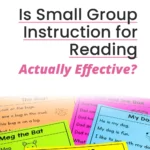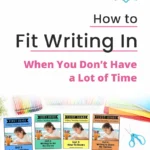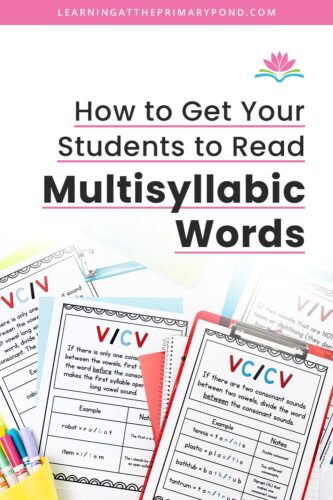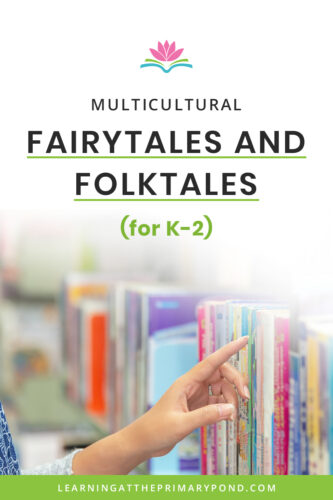Writing conferences and small group writing lessons are fantastic ways to differentiate your writing instruction.
In a writing conference, you typically meet with one student to a) see how their work is going, b) give positive reinforcement about a strategy they are using correctly, and c) teach or review a strategy. You can read more about how to conduct writing conferences in this post.
Small group writing lessons are similar, but they take place with a couple of student at a time. They’re designed to provide targeted instruction to 2-5 kids who have a similar need or who can benefit from being challenged in a certain way. You can read more about how to conduct small group writing lessons here.
However, even if you know how to conduct writing conferences and small group writing lessons, they can still be really challenging to implement. And one of the biggest challenges, in my opinion, is figuring out what to teach during a conference or small group.
At face value, it seems like it might be clear cut. Just teach or reinforce whatever you taught in your writing minilesson that day, right? Well…maybe not.
What if you taught a lesson on including humorous thought bubbles in a story, but a student is writing about when her grandfather passed away?
Or what if you taught a lesson on writing an engaging conclusion, but a few of your students have labels on their pictures and no complete sentences?
Or what if your lesson was on different ways to plan a nonfiction book, but many of your kids are right in the middle of drafting?
You get the picture.
The content of your minilesson does not always = good content for a writing conference or small group (you probably knew that already!).
The challenge, then, is figuring out how to create continuity. How can we teach writing conferences and small group lessons that meet students’ needs yet are still relevant to our whole class instruction and overall goals?
Honestly, I don’t think there’s one right answer to this question. But in this post, I’ll share my personal process and a freebie!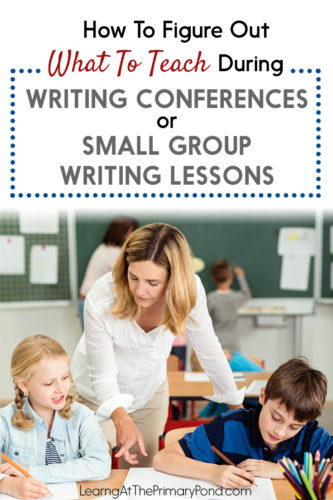
Photo Credit: Racorn, Shutterstock
Ahead-of-Time Planning vs. “In The Moment” Decision Making
First, I want to differentiate between ahead-of-time planning and “in the moment” decision-making.
Sometimes, I plan out ahead of time what I’m going to be working on during a one-on-one conference or small group lesson. Here are some situations when I would decide ahead of time what I will be teaching:
- I’ve been reviewing student work and have seen an area of need or a way to challenge a single student or group of students. I then schedule either a writing conference or small group lesson to address this.
- I’ve been working on a particular strategy with a student or group of students. I know that they need more support, so I plan a follow up writing conference or small group lesson.
However, I don’t always know ahead of time what I will be teaching during a conference or small group lesson.
And it’s not because I didn’t have time to plan (although, hello, we all know that can happen, too!). It’s usually because I have intentionally scheduled time to meet with a student and find out what she is working on. I may need to have an in-depth conversation with the child to really learn what she is thinking, and how I can help her. So I have to decide what I’ll teach her during the actual conversation.
Or, in the case of small groups, I want to observe the class working, and then pull together students who have similar needs based upon my observations. Sometimes, when I’m walking around the room, I can easily see that certain kids are struggling with a concept. This type of “on the fly” small group instruction can be really helpful when we’re working on something new, or transitioning between stages in the writing process.
For example, some of my Kinders have trouble transitioning between a graphic organizer and regular writing paper when I introduce a new graphic organizer. They sometimes get confused and believe that they are starting a whole new piece, rather than just transferring information. If I see that a couple of kids are having this issue, I can quickly pull them into a small group and do a little more teaching.
When I plan out my writing conferences and small groups for the week, I intentionally leave a bit of time for this type of observation and “on the fly” instruction.
I do schedule kids for individual writing conferences and/or small groups, so that I make sure I get to everyone (hopefully!) throughout the period of a week. But then I’ll leave 10-15 mins each day (depending upon how long my writing block is) for pulling together small groups and/or conducting conferences based upon what I’m seeing that very day.
Deciding What To Teach During Ahead-Of-Time Planning
Deciding what I’ll teach ahead of time feels a little less scary than making those in-the-moment decisions. But it can still be challenging!
The one time when (in my opinion) it’s not super challenging is when you have already taught a student or group of students a skill, but they still need more work with it.
Following up with additional lessons is SUPER valuable. You may focus on the same strategy for 2-3 conferences/small group meetings in a row, if it’s a valuable strategy and it’s not quite sticking for the students. To do so, you can review the skill in a different way than when you taught it the first time – by choosing a different mentor text, doing shared or interactive writing, modeling writing, etc. (Leah Mermelstein suggests this in her book Self-Directed Writers).
However, we’re not always following up. Sometimes we have to choose a new teaching point.
For me, the easiest way to do so is to sit down with my unit goals (I always list those out in my writing units – if you have a rubric or checklist, grab that for your planning). I reread them before I start looking at student work, so I know what to look for.
When I see a clear difference between a goal and a student’s writing, I know that it could be something I can cover during a conference or small group lesson. But I have to dig a little deeper. Before planning to meet with the student about this topic, I ask myself:
- Is this goal applicable to the piece the student is working on at the moment?
- Is this goal “within reach”?
Here’s what I mean by “within reach:” Let’s imagine that one of my 2nd grade unit goals is that students will use time/temporal words (first, next, later) to tell when things happen in their stories.
But one of my students didn’t include these words. The events in his story are listed out of order, and it’s not even clear if they are all relevant to his topic.
In this case, I wouldn’t just jump into teaching him how to use temporal words. Although it’s a unit goal, it’d make much more sense for me to teach the student to a) ensure that all events listed are relevant to the story, or b) write about the events in the order that they happened.
On the other hand, what if a student IS meeting all of the unit goals? Should I just skip a conference with him?
Definitely not! This is an opportunity for me to figure out how I can help the student apply a strategy in a more sophisticated way.
For instance, let’s say I’m teaching students how to add details to their personal narratives. I sit down to work with a first grade writer who includes lots of details in his personal narrative. The first grader wrote all about what he saw at the zoo.
But maybe his descriptions don’t have many adjectives. For example, he wrote, “We watched the monkeys swinging on branches.” That’s a good sentence – but I could teach him to make it even better by adding adjectives: “We watched the tiny monkeys swinging on branches” or “We watched the monkeys swinging on high branches.”
Basically, although unit goals are a fantastic starting place, I often have to go up or down a “ladder” of related skills in order to find a “within reach” skill for a particular student or group of students. I think about a continuum of related skills, and where a student’s learning “falls” on that continuum.
If you use my skill continuums for reading, you know that this is how I differentiate instruction when I teach reading, too. And guess what? I have skill continuums for writing now, too!
The skills on each continuum go from easier to more difficult. You can work on one skill with one group of students and a different skill with another – all while focusing on the same ultimate goal!
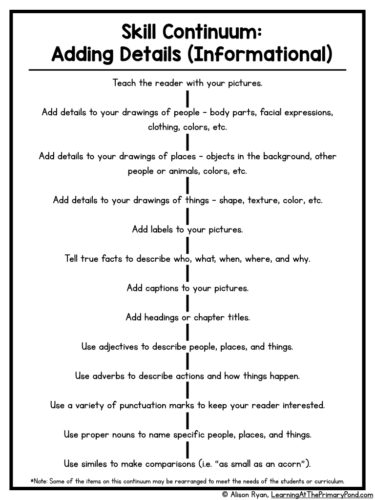
Fill in your information below, and they’ll be sent to you automatically!
FREE Skill Continuums!

Fill in your information and get the writing skill continuums automatically emailed to you!
Success! Now check your email to get the freebie!
In a nutshell, here’s how I make instructional decisions ahead of time for conferences or small groups:
- I review unit goals.
- I look at students’ writing/my notes on their work.
- I look for areas of need or opportunities for challenging them, looking back at the unit goals and using the skill continuum as a guide.
Deciding What To Teach When Making Decisions “In The Moment”
When you sit down with a student and have just 5 precious minutes for a writing conference, you’re under pressure. You need to figure out what to teach the child, and quickly! Yikes!!
Here’s a series of questions I ask myself when I have to make an on-the-go teaching decision (it’s quite similar to the planning process I described above):
- When it comes to the minilesson, are they “getting it”? Could the student benefit from further instruction or more review?
- Is the minilesson goal relevant to the student’s current piece?
- Is the minilesson goal “within reach?” If the answer to the first 3 questions is ‘yes,’ then I have a clear plan of action. But if not, I continue asking questions:
- Is there another strategy we’ve worked on very recently that I could help this student with? (Referring to a checklist/rubric can be helpful with this.)
- If I moved up or down a skill continuum, would I be able to better meet this student’s needs?
Usually, I have some idea about what to teach after I’ve mentally gone through this series of questions.
But there have been PLENTY of times when I’m honestly not sure what to teach a student. This can happen when I see lots of areas for growth – then I’m not sure what to choose! But more often, it happens when a student’s writing looks pretty good at first glance.
When a child is on-track with his or her writing, it’s tempting to fall back on writing conventions as your teaching point. And sure, it’s important to help kids use spelling strategies, correct capitalization and punctuation, and so on.
But if that’s all I ever talk about with my more-skilled writers, am I helping them move forward? Not really!
This is where a skill continuum can be really helpful. If I can quickly see “what’s next,” I can challenge the writer without going and teaching a completely new and different strategy. And if I can, I’d rather extend learning than try and teach an entirely new strategy from scratch.
And if you’re still not sure what to teach? Just give the child a compliment, mention that you’re going to think more about how to help him as a writer, and move on. The information you gained from the conference is still valuable, and spending time one-on-one with a student is never time wasted!
Conclusions
My processes for planning ahead of time and in the moment are really pretty similar. The two main differences are that:
- I consider the day’s minilesson topic and what I’m seeing kids do “right now” when I make decisions in the moment, and
- I have more time to make my decision when I plan ahead of time!
Both kinds of instructional decision making are important, in my opinion. Planning ahead is so useful, but we also have to be ready to respond to our students in the midst of writing.
I hope that sharing my process with you, as well as the skill continuums, will be helpful in your own decision-making. Happy teaching!
References
Mermelstein, L. (2013). Self-Directed Writers. Portsmoouth, NH: Heinemann.

